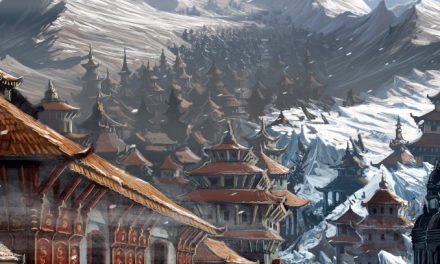One of the books that most formed my early gaming experience was The Way of the Scorpion for the Legend of the Five Rings game system. A deep dive into the politics, mentality, and hidden truths behind one of the most secretive organizations in the setting, it presented the aims, motivations, and actions which formed the bedrock of their Clan.
One of two highly-political Clans in the Empire, unlike the Crane they (on the whole) didn’t trade in favors and pleasantries—their business was blackmail and bribes, assassinations and threats to see their will be done. For some players, this made them attractive as the outsiders within a very regimented society, with more perceived freedom than samurai of other Clans. For others, they were a terrible scourge and were one step above masterless ronin, fit to be wiped off the planet, save for the Emperor’s continued support.
The entire book talks about what sets the Scorpion apart, including their talented geisha and acting troupes, the illusion-casting shugenja, and bushi who always had the upper hand, at least striking from surprise. Different classes and possible character story elements were defined and explored, the intense disconnect between what society said a samurai should be and how the Scorpion taught their children. There’s a lot of interesting conflict therein, but this wasn’t enough for some players.
In the world of Legend of the Five Rings, the concept of “ninja” is as preposterous as our modern notion of the “boogie man.” Someone may claim that ninja came in the night and stole his precious documents, but any such claims would be dismissed outright—ninja are a fiction children are told to ensure they don’t wander out after dark. There is functionally no truth to the rumors, any of them. Still though, John Wick (the author of Way of the Scorpion and much of L5R the original L5R setting material in general) continued to receive requests for mechanics on how to play a ninja.
Eventually, he revealed what it took to be a ninja in the world of Rokugan.
After a truly interesting out-of-game look at the process of playtesting the world and the Clans in particular, about how to make sure other characters understand the value of a positive friendship with a Scorpion, he wrote a second appendix to the book, all about the (in)famed Scorpion ninja school.
At game start each ninja character had only half of the attributes and barely a fraction of the skills with which a normal samurai would be built. Their weapons and tools were of terrible quality, apt to break or fail at every opportunity. The characters would have to pretend to be fully-fledged samurai while both being woefully unprepared and taking on whatever cruel extra duties their ninja master would have of them—carrying a blown-out egg shell for weeks without it breaking, getting a coded message to assigned contacts while under the rest of the party’s watchful eyes, et cetera.
In short, trying to play a ninja was objectively terrible, but John Wick had provided the rules for doing so and no few campaigns had a player trying to survive (let alone succeed) with this dangerous and highly failure-prone endeavor.
One thing I really appreciated about the Way of books (one for each Clan plus a few others) was that their sidebars were filled with additional information, often flavor-text which genuinely helped the reader get into the mind of the Clan. The Scorpion book had pages and pages which detailed their private and internal culture, almost all of which would be ignored by someone racing to the back pages to see how to play a ninja in the world of Rokugan.
A careful, or at least thoughtful, read of the Way of the Scorpion showed that all of the elements for clandestine missions were already included—geisha provided secret intelligence, actors trained in makeup and costuming could pose as potential marks, powerful illusion-casting shugenja provided distractions, and the stealthy bushi provided the more physical arm of a mission. One of the biggest lessons which comes from a purposeful reading of the book was that no Scorpion succeeds on their own merit. Just like every spy has their web of contacts, support, and handlers, so too do the Scorpion, who understand in their core that only through the strength of their community will they survive.
The entire book was telling the reader how “ninja” actually work in Rokugan, how secret dealings and underhanded slander actually helped make the world turn. Someone just looking for mechanics while ignoring all of the rich flavor—admittedly many who would think to play Scorpion in the first place—would bash their head against an impossible (by design) barrier to entry, while those who understood the nuance and subtlety with which the book was written would see straight to the heart of the matter.
John Wick even went so far as to explicitly state this within the book itself! In one continuing series of margin notes there are “Little Truths” which are specialized koans or adages which serve both as in-character reminders and out-of-character hints to the methods and aims of the Scorpion. One of them, which would make zero sense in-character, simply says:
Appendix Two was a lie.
The next time you are thinking about playing a character that breaks the standard mold for the setting, the environment, or the game, take a good look at the real reasons that character may exist, and don’t just focus on the mechanics.














